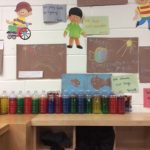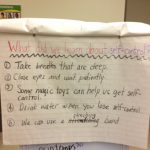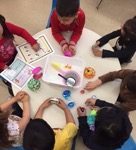This project was done to promote and encourage the use of self-regulation activities in full-day kindergarten students in hopes of creating inclusive and supportive classrooms. The team met two times to discuss and explore resources and then developed a co-teaching lesson plan. The co-teaching lesson plan helped the team disseminate the knowledge of resources and the physical resources purchased with the help of the TLC grant to the other kindergarten classes in the school. After the co-teaching experience, insights from reflections and discussion were gathered from both the team members and the other classroom teachers who participated in the co-teaching. These insights on some challenges, successes and possibilities are briefly shared in this report.
Team Members
Manu Sharma
Toronto District School Board
Sarah Mercer
Toronto District School Board
Simpal Dhingra
Toronto District School Board
Omima Omer
Toronto District School Board
Professional Learning Goals
- An increased sense of co-learning by co-creating self-regulation activities and techniques
- Understanding of the connection between self-regulation and well-being
- Created a consciousness around how to create inclusive practices that address the needs of students with and without special needs
- Refined, adapted and applied self-regulation activities and techniques while considering different classroom communities
- Co-taught and mentored our fellow colleagues with these self-regulation activities and techniques
Activities and Resources
Co-Teaching and Learning Together with our Colleagues
We enjoyed reviewing and exploring different resources (some techniques seen online and some physical materials) to be purchased to support our project. After discussing and examining resources, we decided on what we could purchase with our budget. As a result, we were able to put together seven resource bins for seven full-day kindergarten classes in our school.
The contents of the resource bin are:
- labels
- a visual feelings chart and companion choice board
- The Feelings Book by Todd Parr
- 6 different sensory timers and liquid toys
- mirror
- 8 magnets
- magnifying glass
- soft ball
- sensory balls
- blue tack
- exercise band
- larger feeling poster with visual images
We used these resources along with a co-teaching lesson plan we designed to help disseminate our learning about self-regulation practices and techniques to our colleagues.
The following is the lesson plan we designed and we think it could be a teacher resource to other teachers who are looking to start implementing self-regulation practices in their full-day kindergarten classrooms.
Co-teaching Lesson Guidelines
MINDS ON: 10 minutes
Just Breathe by Julie Bayer Salzman and Josh Salzman (Wavecrest Films)
Guiding Comprehension Questions
What are the students saying about getting angry?
What did the little girl say the brain looks like when someone is angry or has no self-control?
What are the students say we can do to calm down?
What did the student in the video watch in her shaker bottle to calm down?
Why do you think the video was called Just Breathe?
*Body Break – stretches or some quick movement activity
MAIN ACTIVITY: 15 minutes
ON CHART PAPER
Explain what does self-control mean. Please note we used “self-control” instead of “self-regulation” as the students seem to understand this word better. Use visuals and keywords from students.
*Pick a definition you like or use this one: Self-Control is the thinking skill that helps children learn to control their feelings and behaviours in order to make good decisions.
CHART TABLE (Examples of no self-control and how to address it)
Can you give examples of when you are not in self-control?
E.g. When you play at the centres and you want to stay at only one centre the whole time and it makes you angry to change your centre.
E.g. When you talk over other friends in the class.
E.g. When you don’t wait your turn and you pull toys out of your friends’ hands.
E.g. When you use words like “I don’t care” or you get so angry you start to yell.
The contents of the resource bin are:
- labels
- a visual feelings chart and companion choice board
- The Feelings Book by Todd Parr
- 6 different sensory timers and liquid toys
- mirror
- 8 magnets
- magnifying glass
- soft ball
- sensory balls
- blue tack
- exercise band
- larger feeling poster with visual images
Make a table with these two sections:
| NO OR LITTLE SELF-CONTROL | HOW TO ADDRESS IT USING THE BASKET MATERIALS |
Let everyone know we will make a shaker bottle that will help and that your teacher will have the basket of things that may help with self-control.
*SONG: “I can settle down” by David Kisor
CONSOLIDATE: 5 minutes
What did we learn about self-control today?
Review some key pieces.
Share that during centres you and the class teacher will help all the students make a shaker.
As the guest teacher in the classroom, please be mindful of sharing your ideas and plans with your co-teacher in advance. And feel free to change according to what works best for the both of you.
Please be sure to do the followup co-teaching reflection.
In addition to the lesson plan provided above, we also shared online websites and tools that could help facilitate understanding self-regulation for the teacher and ultimately the students in class. Please see below our “Practical Teaching Resources for Your Professional Consideration.” Beyond this, we also asked for a self-reflection to be done by both co-teachers, please see the template below.
Practical Teaching Resources for Your Professional Consideration
ConnectABILITY is a virtual community focused on lifelong learning and support for children, youth and adults with an intellectual disability, their families, caregivers and support networks. It has visual support frames to add in your personalized pictures (using an iPad Mini or any electronic device from the school).
This site specializes in sensory integration and sensory processing.
http://www.edu.gov.on.ca/eng/general/elemsec/speced/autismSpecDis.pdfT
This resource contains information, strategies and practices that can be put to use in the school, and in elementary and secondary classrooms.
https://www.youtube.com/watch?v=kv455O7sWtE
Stick figure video done with student-friendly language for understanding self-regulation.
http://www.edugains.ca/newsite/fulldaykinder/videoselfregulation.html
Visual videos for teachers to identify what self-regulation looks like in the classroom.
https://self-regulationintheclassroom.wikispaces.com/Games+and+Exercises
A wiki site with possible songs and activities used to prompt self-regulation in school.
https://www.bcteacherregulation.ca/documents/Learn/2012/LearnMagazine_Summer_2012.pdf
Looks at Dr. Shanker’s definition of self-regulation and how it has been taken up in British Columbia.
http://canlearnsociety.ca/wp-content/uploads/2013/03/LC_Self-Regulation_N2.pdf
Looks at what Alberta’s approach is to self-regulation through the Can Learn Society.
The following is the co-teaching reflection that was used at the end of the co-teaching experience:
Self-Regulation Co-teaching Reflection
- How did the above (co)-teaching lesson work for you in the classroom space?
___________________________________________________________________________________________________________________________________________________________________________________________________________________________________________
- Did the students learn something about self-control? How do you know?
____________________________________________________________________________________________________________________________________________________________________________________________
- How useful will these techniques and resources be to your class?
____________________________________________________________________________________________________________________________________________________________________________________________
- What concerns have been missed in this approach to self-control? Can you think of any difficulties that would render these methods unsuccessful?
_____________________________________________________________________________________________________________________________________________
- Do you have any further suggestions, comments, or questions?
_____________________________________________________________________________________________________________________________________________
Thank you for your time, efforts and input!
Unexpected Challenges
Reflecting on our Learning
We learned that such a co-teaching lesson should be done earlier in the year to help set up the tone of the classroom. One key insight we had was that students respond better to understanding “self-control” instead of “self-regulation” so we adapted this in our co-teaching lesson, but our research was informed by our informed understanding of self-regulation.
Also, we received feedback from those who participated in co-teaching that a lot of practice needs to happen to maintain the use of these self-regulation techniques. In addition, many concerns were raised about the overall challenges with full-day kindergarten classes such as class sizes, classroom space, professional training and opportunities to learn about self-regulation, support from administration, collaboration with parents, and classroom budgets.
Enhancing Student Learning and Development
One of the key concerns that caught our attention was that students with special needs might need further support with self-regulation especially when they do not comprehend inferences, emotions and their impact on other students or adults in the classroom. For example, students who are on the autism spectrum disorder continuum or those with anger/violent behaviours in full day kindergarten classroom spaces may present challenges that require other professionals to assist with greater equity and learning concerns before self-regulation techniques can be successfully implemented.
In general, the sensory items and self-regulation techniques purchased helped the majority of students in the full-day kindergarten setting. These items and best practices allowed for redirecting students when they were upset in order to return to the regular classroom routine. In addition, it allowed for students to help their peers by reminding them of how to self-control their emotions with the aid of the calm down kit (which contained all the sensory products).
Thus, student learning about self-control was promoted and its contribution and application to the development of the student was shared.
Sharing
Sharing with Parents about our Learning
In addition to sharing all that we learned with the full-day kindergarten teachers in the school via the co-teaching experience, we also had an opportunity to share the images from our co-teaching lesson and resources with the parents of our future students in the full-day kindergarten program on the Welcome to Kindergarten Information Morning.
We used some of the pictures we took during the co-teaching experience in order to share the importance of self-regulation practices at home and at school. The hope is to create some consistency between both the home and school environment thus allowing for a smoother transition for all our students.
Project Evaluation
We found this TLC project opportunity an insightful and hopeful one. It has overall allowed us to have discussions that created a deeper understanding of how to begin the dialogue about self-control in our full-day kindergarten classrooms with the support of different resources and techniques, and for that we are very grateful. We hope that our resources and insights are helpful to all full-day kindergarten teachers who are curious to learn more about self-regulation and implementing strategies to ensure the healthy well-being of our full-day kindergarten students!
Resources Used
ConnectABILITY is a virtual community focused on lifelong learning and support for children, youth and adults with an intellectual disability, their families, caregivers and support networks. It has visual support frames to add in your personalized pictures (using an iPad Mini or any electronic device from the school).
This site specializes in sensory integration and sensory processing.
http://www.edu.gov.on.ca/eng/general/elemsec/speced/autismSpecDis.pdfT
This resource contains information, strategies and practices that can be put to use in the school, and in elementary and secondary classrooms.
https://www.youtube.com/watch?v=kv455O7sWtE
Stick figure video done with student-friendly language for understanding self-regulation.
http://www.edugains.ca/newsite/fulldaykinder/videoselfregulation.html
Visual videos for teachers to identify what self-regulation looks like in the classroom.
https://self-regulationintheclassroom.wikispaces.com/Games+and+Exercises
A wiki site with possible songs and activities used to prompt self-regulation in school.
https://www.bcteacherregulation.ca/documents/Learn/2012/LearnMagazine_Summer_2012.pdf
Looks at Dr. Shanker’s definition of self-regulation and how it has been taken up in British Columbia.
http://canlearnsociety.ca/wp-content/uploads/2013/03/LC_Self-Regulation_N2.pdf
Looks at what Alberta’s approach is to self-regulation through the Can Learn Society.
Resources Created
These resources will open in your browser in a new tab, or be downloaded to your computer.








